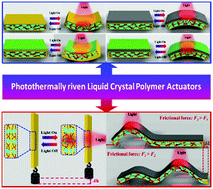当前位置:
X-MOL 学术
›
Mater. Chem. Front.
›
论文详情
Our official English website, www.x-mol.net, welcomes your
feedback! (Note: you will need to create a separate account there.)
Photothermally driven liquid crystal polymer actuators
Materials Chemistry Frontiers ( IF 6.0 ) Pub Date : 2018-09-10 00:00:00 , DOI: 10.1039/c8qm00363g Liangliang Dong 1, 2, 3, 4, 5 , Yue Zhao 1, 2, 3, 4
Materials Chemistry Frontiers ( IF 6.0 ) Pub Date : 2018-09-10 00:00:00 , DOI: 10.1039/c8qm00363g Liangliang Dong 1, 2, 3, 4, 5 , Yue Zhao 1, 2, 3, 4
Affiliation

|
Liquid crystal polymers (LCPs) have emerged as a material of choice for soft actuators, for which applications have been envisioned in many areas. In contrast to the actuators based on polymer hydrogels whose reversible volume or size change relies on absorption and release of water molecules by the polymer related to a thermal phase transition of the polymer solution, LCPs exhibit macroscopic shape change as a result of LC–isotropic, or order–disorder, phase transition of the mesogens that are part of the polymer structure either in the main chain or as side groups. LCP actuators, in the form of a crosslinked network, can be triggered by various stimuli such as change in temperature, change in humidity, light and electric power. Of these, light is a particularly attractive stimulus owing to the attributes of remote, localized or patterned activation. Until now, the large majority of light-triggered LCP actuators, generally referred to as liquid crystal elastomers (LCEs) or liquid crystal networks (LCNs), are azobenzene-containing polymers, for which the order–disorder phase transition of the azobenzene mesogens is induced by the reversible trans–cis photoisomerization of the chromophore. In recent years, however, there has been growing interest in photocontrolled LCP actuators that involve no photochemical reactions but use simply a photothermal effect to control the order–disorder phase transition. This review is focused on such photothermally driven LCP actuators. Highlighted are examples of reported studies demonstrating the actuation modes and possible applications. We also discuss the advantages of using the photothermal effect and the possibilities of actuator designs. At the end, we provide an outlook for the development of this type of polymer actuator in the near future.
中文翻译:

光热驱动液晶聚合物致动器
液晶聚合物(LCP)已经成为软致动器的一种选择材料,其在许多领域都已得到了应用。与基于聚合物水凝胶的致动器不同,其可逆的体积或大小变化取决于与聚合物溶液的热相变有关的聚合物对水分子的吸收和释放,而LC-各向同性的结果是LCP表现出宏观的形状变化,介晶是聚合物结构的一部分,在主链中或作为侧基,即有序或无序的相变。交联网络形式的LCP执行器可以通过各种刺激来触发,例如温度变化,湿度变化,光和电功率。其中,由于偏远,局部或模式激活。到目前为止,大多数光触发LCP执行器(通常称为液晶弹性体(LCE)或液晶网络(LCN))是含偶氮苯的聚合物,偶氮苯液晶元的有序-无序相变是由可逆引起发色团的反式-顺式光异构化。然而,近年来,人们对不涉及光化学反应但仅使用光热效应来控制有序-无序相变的光控LCP执行器的兴趣日益浓厚。本文的重点是此类光热驱动的LCP执行器。突出显示了已报道的研究实例,这些实例证明了驱动模式和可能的应用。我们还将讨论使用光热效应的优势以及执行器设计的可能性。最后,我们提供了在不久的将来开发这种类型的聚合物致动器的前景。
更新日期:2018-09-10
中文翻译:

光热驱动液晶聚合物致动器
液晶聚合物(LCP)已经成为软致动器的一种选择材料,其在许多领域都已得到了应用。与基于聚合物水凝胶的致动器不同,其可逆的体积或大小变化取决于与聚合物溶液的热相变有关的聚合物对水分子的吸收和释放,而LC-各向同性的结果是LCP表现出宏观的形状变化,介晶是聚合物结构的一部分,在主链中或作为侧基,即有序或无序的相变。交联网络形式的LCP执行器可以通过各种刺激来触发,例如温度变化,湿度变化,光和电功率。其中,由于偏远,局部或模式激活。到目前为止,大多数光触发LCP执行器(通常称为液晶弹性体(LCE)或液晶网络(LCN))是含偶氮苯的聚合物,偶氮苯液晶元的有序-无序相变是由可逆引起发色团的反式-顺式光异构化。然而,近年来,人们对不涉及光化学反应但仅使用光热效应来控制有序-无序相变的光控LCP执行器的兴趣日益浓厚。本文的重点是此类光热驱动的LCP执行器。突出显示了已报道的研究实例,这些实例证明了驱动模式和可能的应用。我们还将讨论使用光热效应的优势以及执行器设计的可能性。最后,我们提供了在不久的将来开发这种类型的聚合物致动器的前景。











































 京公网安备 11010802027423号
京公网安备 11010802027423号